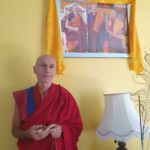Geshe Samten Tsukphu learned various calligraphic styles of writing at a young age and can reproduce many different scripts. Shenten Dargye Ling asked its resident lama to lead a workshop on Tibetan calligraphy for those interested in learning the basics of this contemplative discipline.The seminar is going to take place in the month of June.
Geshe la, what are you going to teach the participants at the workshop?
To people who are interested in Tibetan calligraphy, I would like to show the two main types of script – which we call “black” and “white”. How they look and how to write them. Within both categories there are many writing sub-styles, but I want to keep the workshop simple, and will introduce only one example of each category.
How many writing styles do you know and can perform?
Quite many. More than one thousand.
Really???
Just joking (Geshe la is laughing).
You remind me more and more of Yongdzin Rinpoche, there is a certain way of speaking and behaving that is common. Maybe not everyone knows that you are a relative of our root master, H.E. Yongdzin Tenzin Namdak Rinpoche…
Oh! Good! (Geshe la is laughing). You put what is necessary in the interview, and what is not you please remove.
I would like to keep your jokes though. Now, back to the topic of calligraphy. Can you explain to us the “white” and “black” scripts, what is the main difference?
White calligraphy is called yig-kar in Tibetan, “yig” means a letter, “kar” is karpo – white. The white script is the one that is most familiar to Westerners, and it is also more commonly used among Tibetans. Scholars, Tibetologists, also usually know the white script. Not many of them know the black style. They need to learn whatever is more usable for their research. In the “Western style” books written in Tibetan, we use the white script.

We call the script “white” because there is more space within the letters. Letters in the “black” script, on the contrary, are more compact. Black script is often used in calligraphy. Also, small children are sometimes given a task to reproduce this script because it is more like drawing than writing and it functions to train their focus.
Your online magazine, Melong Yeshe, written in Tibetan for the worldwide Tibetan public, is written in white script, right?
Yes.
An interview with Geshe Samten Tsukphud about the Melong Yeshe
So, do I understand well that the black calligraphy is more decorative, ornamental, and artistic?
Yes. We can find it in the ancient “pecha” books – the Tibetan traditional blocks of separate sheets of paper wrapped in a textile. Most Bonpo pecha books are written in the black script. Nowadays, it can also be found on prayer flags, for example, it is used in woodblock printing, as I think this script is easier to carve on wood.
Is Bonpo way of writing different?
We believe that both the white and black scripts came to Tibet from Zhang-Zhung. We have studied some Zhang-Zhung scripts, and they also had black and white styles. Bonpo culture is connected to the ancient culture of Zhang-Zhung. We believe the script used in Tibet was created earlier than the 7th century.

How did you learn Tibetan calligraphy?
In my village school back in Kham where I grew up, I started to learn the white style. By myself, I got interested in the black calligraphy a little later. I studied different styles of black script and trained to reproduce them. I wrote down many prayer books in a calligraphic manner.
Is it possible to learn Tibetan calligraphy for a Westerner who does not know the Tibetan language, at least to some degree?
Well, the best way is a natural way of learning, just by seeing and trying. If you start to concentrate too much on all the rules that exist for writing, you get blocked, you will lose your natural flow. There are lots of instructions to follow but I think the best is just to relax and learn naturally.
During the June seminar, people will be able to observe me and then try themselves, at their own pace and according to their abilities. They will get familiar a little bit, both with calligraphy and with Shenten, which is a really beautiful place and good for meditation.
It is a bit surprising to me that people want to learn calligraphy and not meditation. But it is true that calligraphy is a contemplative activity. It has a positive effect on our mind, and it helps it with focusing. I use it to rest and relax.
Photos: Jitka Polanska
“Bonpo scriptures say that the Tibetan writing system came from the forty magical letters of Zhangzhung: thirty consonants, six vowels, and four pronunciations.”
From A New Look at the Tibetan Invention of writing by Sam Van Schaik
about the workshop:
Tibetan Calligraphy with Vinaya Khenpo Samten Tsukphu (June 16 – 21, 2024)
Tibetan calligraphy is more than a visual art; it is a spiritual practice and a form of meditation in motion. Each stroke and form in Tibetan writing carries deep spiritual and aesthetic meaning. This ancient art is a way of expressing and preserving sacred teachings, offering a window into the rich culture and spiritual heritage of Tibet.
In this seminar, you will explore the basics of Tibetan calligraphy, including its various forms and styles. Vinaya Khenpo Samten will guide participants through fundamental techniques, allowing everyone to connect with this unique form of artistic and spiritual expression.
Whether you are a beginner or experienced in the art of calligraphy, this seminar offers a wonderful opportunity to learn and practice under the guidance of an experienced master. You will not only develop calligraphy skills, but also a deeper appreciation for the meditative and contemplative dimension of this art.












